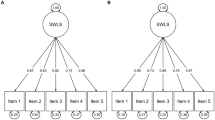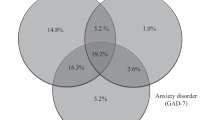Abstract
Purpose
Persecutory delusions are one of the key problems seen in psychotic conditions. The aim of the study was to assess for the first time the levels of psychological well-being specifically in patients with current persecutory delusions.
Method
One hundred and fifty patients with persecutory delusions in the context of a diagnosis of non-affective psychosis, and 346 non-clinical individuals, completed the Warwick-Edinburgh Mental Well-Being Scale and symptom assessments.
Results
Well-being scores were much lower in the persecutory delusions group compared with the non-clinical control group. 47 % of the persecutory delusions group scored lower than two standard deviations below the control group mean score. Within the patient group, psychological well-being was negatively associated with depression, anxiety, and hallucinations. In both groups, lower levels of well-being were associated with more severe paranoia.
Conclusions
Levels of psychological well-being in patients with current persecutory delusions are strikingly low. This is likely to arise from the presence of affective symptoms and psychotic experiences. Measurement of treatment change in positive mental health for patients with psychosis is recommended.

Similar content being viewed by others
References
Sartorius N, Jablensky A, Korten A, Ernberg G, Anker M, Cooper JE, Day R (1986) Early manifestations and first-contact incidence of schizophrenia in different cultures. Psychol Med 16:909–928
Wessely S, Buchanan A, Reed A et al (1993) Acting on delusions (1): prevalence. Br J Psychiatry 163:69–76
Applebaum PS, Robbins PC, Roth LH (1999) Dimensional approach to delusions: comparison across types and diagnoses. Am J Psychiatry 156:1938–1943
Castle DJ, Phelan M, Wessely S, Murray RM (1994) Which patients with non-affective functional psychosis are not admitted at first psychiatric contact? Br J Psychiatry 165:101–106
Freeman D, McManus S, Brugha T, Meltzer H, Jenkins R, Bebbington P (2011) Concomitants of paranoia in the general population. Psychol Med 41:923–936
Freeman D, Garety P, Fowler D, Kuipers E, Dunn G, Bebbington P, Hadley C (1998) The London-East Anglia randomised controlled trial of cognitive behaviour therapy for psychosis IV: self-esteem and persecutory delusions. Br J Clin Psychol 37:415–430
Smith B, Fowler D, Freeman D, Bebbington P, Bashforth H, Garety P, Kuipers E, Dunn G (2006) Emotion and psychosis: direct links between schematic beliefs, emotion and delusions and hallucinations. Schizophr Res 86:181–188
Brohan E, Elgie R, Sartorius N, Thornicroft G (2010) Self-stigma, empowerment and perceived discrimination among people with schizophrenia in 14 European countries. Schizophr Res 122:232–238
Norman R, Malla A, Mclean T, Voruganti L, Cortese L, McIntosh E, Cheng S, Rickwood A (2000) The relationship of symptoms and level of functioning in schizophrenia to general well-being and the Quality of Life Scale. Acta Psychiatrica Scawndinavica 102:303–309
Freeman D, Garety PA, Bebbington PE, Smith B, Rollinson R, Fowler D, Kuipers E, Ray K, Dunn G (2005) Psychological investigation of the structure of paranoia in a non-clinical population. Br J Psychiatry 186:427–435
Bentall R, Wickham S, Shevlin M, Varese F (2012) Do specific early-life adversities lead to specific symptoms of psychosis? A study from the 2007 adult psychiatric morbidity survey. Schizophr Bull 38:734–740
Kendler K, Myers J, Maes H, Keyes C (2011) The relationship between the genetic and environmental influences on common internalizing psychiatric disorders and mental well-being. Behav Genet 41:641–650
Mankiewicz P, Gresswell D, Turner C (2013) Subjective well-being in psychosis. Int J Wellbeing 3:35–59
Tennant R, Hiller L, Fishwick R, Platt S, Joseph S, Weich S, Parkinson J, Secker S, Stewart-Brown S (2007) The Warwick-Edinburgh Mental Well-being Scale (WEMWBS): development and UK validation. Health Qual Life Outcomes 5:63. doi:10.1186/1477-7525-5-63
Stuart-Brown S, Janmohamed K (2008) Warwick-Edinburgh Mental Well-being Scale (WEMWBS). User Guide Version 1. NHS Health Scotland
Crawford M, Robotham D, Thana L, Patterson S, Weaver T, Barber R, Wykes T, Rose D (2011) Selecting outcome measures in mental health. J Ment Health 20:336–346
Department of Health (2013). Mental health payment by results guidance for 2013–14. https://www.gov.uk/government/uploads/system/uploads/attachment_data/file/141396/Mental-Health-PbR-Guidance-for-2013-14.pdf.pdf (Accessed 16th May 2013)
Freeman D, Dunn G, Startup H, Kingdon D (2012) The effects of reducing worry in patients with persecutory delusions: study protocol for a randomized controlled trial. Trials 13:223
Freeman D, Garety PA (2000) Comments on the content of persecutory delusions: does the definition need clarification? Br J Clin Psychol 39:407–414
Haddock G, McCarron J, Tarrier N, Faragher FB (1999) Scales to measure dimensions of hallucinations and delusions: the psychotic symptom rating scales (PSYRATS). Psychol Med 29:879–889
Startup HM, Erickson TM (2006) The penn state worry questionnaire (PSWQ). In: Davey GCL, Wells A (eds) Worry and its psychological disorders. Wiley, Chichester, pp 101–120
Greenwood K, Sweeney A, Williams S, Gaerty P, Kuipers E, Scott J, Peters E (2010) CHoice of Outcome In Cbt for psychosEs (CHOICE): the development of a new service user-led outcome measure of CBT for psychosis. Schizophr Bull 36:126–135
Green C, Freeman D, Kuipers E, Bebbington P, Fowler D, Dunn G, Garety P (2008) Measuring ideas of persecution and social reference. Psychol Med 38:101–111
Freeman D, Pugh K, Antley A, Slater M, Bebbington P, Gittins M, Dunn G, Kuipers E, Fowler D, Garety P (2008) A virtual reality study of paranoid thinking in the general population. Br J Psychiatry 192:258–263
Freeman D, Pugh K, Vorontsova N, Antley A, Slater M (2010) Testing the continuum of delusional beliefs: an experimental study using virtual reality. J Abnorm Psychol 119:83–92
Kay SR (1991) Positive and negative syndromes in schizophrenia. Brunner, New York
IBM (2011). SPSS Statistics Version 20. Release 20.0.0. IBM Corporation
Foster C, Startup H, Potts L, Freeman D (2010) A randomised controlled trial of a worry intervention for individuals with persistent persecutory delusions. J Behav Ther Exp Psychiatry 41:45–51
Myers E, Startup H, Freeman D (2011) Cognitive behavioural treatment of insomnia in patients with persecutory delusions. J Behav Ther Exp Psychiatry 42:330–336
Freeman D, Evans N, Lister R (2012) Gut feelings, deliberative thought, and paranoid ideation. Psychiatry Res 197:119–122
Powell J, Hamborg T, Stallard N, Burls A, McSorley J, Bennett K, Griffiths K, Christensen H (2013) Effectiveness of a web-based cognitive-behavioural tool to improve mental well-being in the general population. J Med Internet Res 15(1):e2. doi:10.2196/jmir.2240
McCabe R, Saidi M, Priebe S (2007) Patients-reported outcomes in schizophrenia. Br J Psychiatry 191:s21–s28
Wing J (1994) Health of the nation outcome scales: HoNOS field trials. Royal College of Psychiatrists Research Unit, London
Maheswaran H, Weich S, Powell J, Stewart-Brown S (2012) Evaluating the responsiveness of the Warwick Edinburgh Mental Well-Being Scale (WEMWBS). Health Qual Life Outcomes 10:156
Freeman D, Freeman J (2012) You can be happy: the scientifically proven way to change how you feel. Prentice Hall Life, Harlow
Acknowledgments
This project (grant 09/160/06) was awarded by the Efficacy and Mechanism Evaluation (EME) Programme and is funded by the Medical Research Council (MRC) and managed by the National Institute for Health Research (NIHR) on behalf of the MRC-NIHR partnership. DF is supported by a UK Medical Research Council Senior Clinical Fellowship.
Conflict of interest
None.
Author information
Authors and Affiliations
Corresponding author
Rights and permissions
About this article
Cite this article
Freeman, D., Startup, H., Dunn, G. et al. Persecutory delusions and psychological well-being. Soc Psychiatry Psychiatr Epidemiol 49, 1045–1050 (2014). https://doi.org/10.1007/s00127-013-0803-y
Received:
Accepted:
Published:
Issue Date:
DOI: https://doi.org/10.1007/s00127-013-0803-y




